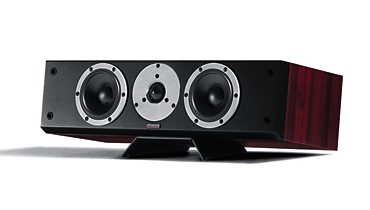DynaudioExcite home theater speaker system Page 2

MUSIC & MOVIE PERFORMANCE
As always, I began by listening to the front pair full-range (no subwoofer) using stereo recordings. What I noticed first was the X16s' thoroughly beguiling treble, which sounded airy, light, and open. Next, I noted the clean, musical content in the bottom octaves, going down to maybe 40 or 50 Hz - although a shadow of the upper-bass warmth that had overpowered their sound when closer to the wall remained.
Heard over the Excite speakers, the vocal regions impressed me as natural and highly articulate, with a very slightly distant quality that somehow seemed to accentuate tonal and spatial details. For example, on the ballad "Cry Me a River" from Bonnie Bramlett's I'm Still the Same, the Dynaudios conveyed the singer's fulsome contralto with genuine power, while also highlighting her considerable skill in wielding breathy nuance and occasional grit. Bass was ample for this sort of small-combo setting: pleasant, but not overly warm. And that treble! The subtle details of the drummer's hi-hat work, though well in the background, were beautifully revealed by the X16s.
When I was 17, I worshipped guitarist Larry Coryell and did my best to play just like him. Now his kids are older than that, and they play better'n I ever did. Sigh. "Zimbabwe," from Larry and sons' The Coryells presents three acoustic guitars, a slappy bass, and busy hand percussion - a veritable orgy of transient attacks. The Dynaudios truly excelled with this recording (by the ever reliable David Chesky), with its rich room ambience actually extending slightly beyond the speakers and well out into the room. Even at lifelike levels, the X16s maintained startling clarity, most memorably on the tambourine "ching" that sounds on the second and fourth beats throughout the cut. (I found both of these tracks, among others, at hdtracks.com. I'm happy to plug any service promoting good - or at least better - sound.)
The X16s didn't produce instrument locations with the pinpoint accuracy other speakers do, sounding a bit more spatially diffuse. Nor did they produce much sound over the bottom octave-plus - unsurprising in a compact "bookshelf" speaker. About midway through my listening, I added the foam "bungs" Dynaudio supplies with each speaker to block the X16 ports for a quasi-sealed alignment (less ultimate bass output, more gradual rolloff). This tightened up the midbass, which I liked, but it didn't have much impact on the overall weight of deep bass. I went back and listened again to these tracks and others once I'd thoroughly dialed in the Sub 250, and I was rewarded by real low-frequency underpinnings with no meaningful sacrifice of the X16s' impressive detail.
 |
Moving on to multichannel, I found that the X22 center performed quite competently. It was a fairly close tonal match to the X16s - closer than I'd expected given their different-size woofers - and held its balance very well over a moderate side-to-side listening angle. (Low-treble "bite" fell off quickly beyond about 30ÃÆ'ââ'¬Å¡Ãƒâ€šÃ'° off-axis, but this listening range will be adequate for most setups.) The smaller X12 Excites proved perfectly adequate in the surround positions. I prefer dipoles, especially for film sound (particularly at these prices!), but I can't say the Dynaudios ever revealed prominent surround failings.
With all 5.1 channels suitably tweaked, I cued up The Bourne Ultimatum DVD. (Bourne is one of those HD DVD orphans not yet out on Blu-ray Disc.) The bantamweight Danes did a very workmanlike job with this two-hour chase sequence; I enjoyed the wide array of ambience in the many crowd scenes, which were all convincingly presented. I also heard smooth quick-pans on the many fast-moving scenes, like the motorbike (Bultaco?) chase through the souks of Tangiers. These scenes frankly sounded smoother than I expected given the design differences between the X16 mains and the X22 center speaker.
All five Dynaudios played extremely loud without objection, using power from my 5 x 200-watt amp to reach truly cinema-like levels with no sign of complaint or serious dynamic restriction. Ultimatum'sclimax has a lot of glass breaking at high volume levels, but even this sequence didn't sound harsh or painful.
Dynaudio's little Sub 250 was a bit of an exception, though it certainly exceeded my visual expectations. It's tiny and can't play terribly loud, but it had plenty of grunt for the ominous (if clichÃÆ'ƒÂÃ'©d) low synth notes in the Ultimatum score. As it approached reference levels, the sub sounded less solid and a bit "flappier," and it stumbled audibly on a couple of big-bass transients. This was mostly masked by other sound-effects mayhem, but it was perfectly audible if you knew what to listen for - which I did, having already exposed the sub by playing it solo.
I also found that the Sub 250's unfiltered response (through its LFE input) had a substantial peak at around 200 Hz - some 10 dB above its average bass output. This effectively negated much of my surround processor's electronic sub-output crossover, and it made high-bass and even midrange content sound far too strong and noticeable. The less-than-ideal solution here was to use the Sub 250's Sat/Sub input with its low-pass filter in the circuit, setting the dial at about noon. The Sub 250 is a competent small sub for small rooms or modest peak-level demands, but there's no question that the system could benefit from a more substantial subwoofer.













































